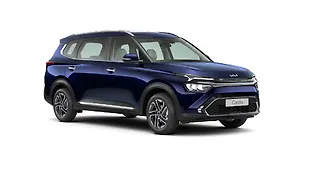What is it?
Why will I buy it?
Premium feature-rich interior, roomy and comfortable cabin, a refined diesel engine.
Why will I avoid it?
Inconsistent ride quality may not appeal to everyone’s liking.

The first time is always special, they say. They also say that the first impression is the last impression. So, here we have the first product from Kia Motors, made exclusively for the Indian market – the Seltos. This Korean SUV arrives at a time when auto sales are plummeting but Kia has managed to price it dynamically to establish itself in a finicky car market like ours. Also, it faces competition from some of the well-established guns like the Hyundai Creta, Nissan Kicks, Tata Harrier and the other new-comer, the MG Hector. And, the Seltos is already giving them a run for their money.

With the Seltos, Kia has managed to retain most of the radical design elements we saw on the SP Concept. Pictures might not do it justice, but in metal, the Seltos surely grabs attention. Firstly, the characteristic ‘tiger-nose’ face has a chrome knurled finish and sleek LED strip on it, which looks interesting. However, the design of the fascia is quite busy – especially with the ‘crown jewel headlamps’, as Kia likes to call it. We also particularly liked the vertically-stacked ‘ice-cube’ LED fog lamps. Apart from the fascia, the long bonnet, squared-off wheel arches, and a floating D-pillar stands out on the Seltos. Also present are the roof rails along with body cladding all around to give the Kia an authentic crossover stance.

At the rear, the chrome bar on the tailgate, which also houses the Kia logo and bridges both the taillights, adds to the bling factor. Kia has also retained its headlight design subtly in the tail light signature, which is a nice touch. There’s a sculpted design on the tailgate with integrated reflectors on either side of the rear quarter panel. But, we aren’t a fan of the insert running across the bumpers which gives an impression of exhaust tips when they are just a mere design element.
Now, looks can be subjective, but, the Kia Seltos sure is a handsome looking car. As we mentioned earlier, it grabs attention and doesn’t come off as overdone in any way. It has a fairly good road presence and easily stands out amongst the crop of SUVs we are used to seeing on our roads.

How is it on the inside?

Step inside the Seltos and you are greeted by an interior that stands apart from its segment rivals. Kia has paid extra attention to keep things premium and it shows; be it the buttons, graphics on the digital screens, or the use of soft-touch materials at essential contact points. Likewise, the fit and finish, and the materials used in the cabin are of high-quality and look durable.

Complementing the plush interiors are the large and comfortable front seats. You get a commanding position with a good view of the surroundings. There’s an electric adjustment for the driver and the steering is adjustable for rake and reach. Kia has also provided a separate tray for wireless mobile charging in the usable centre console. Weirdly though, there’s a provision for a grab handle on the passenger side below the A/C controls in the centre console and not on the driver’s side, which could probably trigger your OCD if you are all for the symmetry.

We are particularly impressed by the floating Mercedes-Benz MBUX-style panel which combines the infotainment screen and instrument cluster. Even the graphics on the 10.5-inch screen is top-notch and it reminds us of a similar user interface employed by BMW and Audi. This system has a quick and precise response to touch and is easy to operate, even when driving. It also gives out a host of information and can control various other functions as well.

Similarly, in the large digital driver information system nestled between two analogue dials, you’ll find trivial yet essential information like wiper setting (both fore and aft), headlamp settings, media details and two trip computers. In the GT-line, this screen doubles up as a blind-spot warning display.

Meanwhile, moving towards the back, the rear seats boast of ample amount of legroom and there’s sufficient headroom as well. Akin to the front seats, the rear bench is comfortable with a decent amount of cushioning. There’s a headrest for all the three passengers and even the middle passenger gets ample knee room despite the rear air vents. The rear seat can be further adjusted for recline by few degrees (four degrees to be precise) which further helps its case. That said, a tad bit of extra under-thigh support here would have made spending time in the rear seats much more comfortable. Lastly, the 433litres of boot space is large and fairly usable because of the low loading lip and flat floor.

Feature-wise, this HTX variant misses out on functions like the heads-up display, 360-camera, blind-spot assist (which turns on ORVM camera’s on the infotainment screen when an indicator is turned on), and contrasting leather upholstery compared to the GT-Line. But you do get powered driver seats, cooled front seats, reverse camera, integrated air-filter, wireless charging, eight-speaker Bose music system with mood lighting (which has a discothèque vibe to it), automatic A/C, TPMS, button start/stop, sunroof, Apple Carplay/Android Auto and Kia’s very own UVO connected car feature.
How does it drive?

Kia is offering three engines and three gearbox options with the Seltos in India. We have already driven the 1.4-litre turbo-petrol with a manual gearbox. What we are driving here is the 1.5-litre CRDi VGT diesel which is mated to a six-speed manual gearbox. This engine is one of the few BS-VI compliant diesel engines on sale currently. Power figures stand at 114bhp at 4000rpm and 250Nm from 1500rpm.

Turn on the ignition and there is barely any noise from the engine at idle or even off-the-line and the diesel motor impressed us with its refinement. Moreover, the light clutch possesses some amount of spongy feel to it along with a long pedal-travel. But, it is usable and the gearbox isn’t notchy and slots in the gear easily. Off the line, there’s sufficient torque from the engine even below 1500rpm but the momentum is gained only past 2000rpm. And this is where the engine starts getting vocal. Even with excellent insulation, the grumbling engine noise is constantly heard inside the cabin, which might not be to everyone’s liking. However, it is to be noted that it doesn’t feel coarse or rough at all and the clatter isn’t as bad as other diesels.

However, what is appreciable is that the engine is very tractable and the mid-range is where it feels the happiest. There’s ample grunt between 2000 and 4000rpm and this reduces the need for constant gearshifts when zipping through city traffic. We barely felt the need to rev the motor to redline even when wanting to go fast on the highway. Driving in the city, the Seltos can easily potter around without the constant need of going up and down the gearbox. However, for quick overtakes, the engine needs to be grinded for that mid-range grunt. Otherwise, it takes its own time to leap ahead in the traffic. Out on the highway, the Seltos is quick on its heel and doesn’t feel strained or unnerving at triple-digit speeds.

On the move, the steering feels overly light and relaxed, but it does weigh up as the speed increases. Even though it could do with better feedback, we could say that it is direct and weighs up nicely at higher speeds. The well-balanced chassis further helps the Seltos in terms of driving dynamics. There’s some amount of body roll though when you put it in a corner, but the stiff suspension setup adds confidence. On the flip side, it makes the ride a bit jarring.

Going over the broken road surfaces with sharp edges or road expansion joints, you can feel every thud sent inside the cabin, especially on the back seats. That said, the Seltos takes astride mildly broken roads with ease and manages to flatten long undulation on roads. There’s also not much of an up and down movement at higher speeds.
Overall, the Seltos feels premium and not rugged from behind the wheel and it emerges as a fun-to-drive SUV.
Should I buy one?

The Seltos is a well-rounded SUV and has made a very impressive first impression indeed. It looks handsome, offers a premium and feature-rich cabin, drives well and is also spacious and practical on the inside. There are no less than six powertrain configurations to choose from which are compliant to the upcoming BS-VI norms already, and the Seltos also brings in many segment-first features. And with its attractive pricing, it also comes across as a value-for-money proposition.
Sure, Kia is a new brand in India and its sales and aftersales service is yet to be proven. But as a product, Kia’s first SUV in India has more going for it and we couldn’t find any reason not to recommend it.
Where does it fit in?

The Kia Seltos is priced in the range of Rs 9.69 lakhs to Rs 16.99 lakhs. This puts it bang in the middle of the mid-size SUV segment which is already populated with the likes of the Hyundai Creta, Renault Duster and Captur, Nissan Kicks, the newly-launched MG Hector and some big guns like the Tata Harrier, Mahindra XUV500 and even few variants of the Jeep Compass. The Seltos’ base to mid-spec variants could also be an alternative for some sub-four metre SUV buyers.
Pictures by Kapil Angane

![Kia Seltos [2019-2022] Exterior Kia Seltos [2019-2022] Exterior](https://imgd.aeplcdn.com/642x361/cw/ec/42567/Kia-Seltos-Exterior-172109.jpg?wm=1&q=80)
![Kia Seltos [2019-2022] Exterior Kia Seltos [2019-2022] Exterior](https://imgd.aeplcdn.com/642x361/cw/ec/42567/Kia-Seltos-Exterior-171909.jpg?wm=1&q=80)
![Kia Seltos [2019-2022] Exterior Kia Seltos [2019-2022] Exterior](https://imgd.aeplcdn.com/642x361/cw/ec/42567/Kia-Seltos-Exterior-171910.jpg?wm=1&q=80)
![Kia Seltos [2019-2022] Exterior Kia Seltos [2019-2022] Exterior](https://imgd.aeplcdn.com/642x361/cw/ec/42567/Kia-Seltos-Exterior-171911.jpg?wm=1&q=80)
![Kia Seltos [2019-2022] Exterior Kia Seltos [2019-2022] Exterior](https://imgd.aeplcdn.com/642x361/cw/ec/42567/Kia-Seltos-Exterior-171912.jpg?wm=1&q=80)
![Kia Seltos [2019-2022] Exterior Kia Seltos [2019-2022] Exterior](https://imgd.aeplcdn.com/642x361/cw/ec/42567/Kia-Seltos-Exterior-171913.jpg?wm=1&q=80)
![Kia Seltos [2019-2022] Exterior Kia Seltos [2019-2022] Exterior](https://imgd.aeplcdn.com/642x361/cw/ec/42567/Kia-Seltos-Exterior-171914.jpg?wm=1&q=80)
![Kia Seltos [2019-2022] Exterior Kia Seltos [2019-2022] Exterior](https://imgd.aeplcdn.com/642x361/cw/ec/42567/Kia-Seltos-Exterior-171915.jpg?wm=1&q=80)
![Kia Seltos [2019-2022] Image Kia Seltos [2019-2022] Image](https://imgd.aeplcdn.com/272x153/n/cw/ec/33372/seltos-exterior-right-front-three-quarter-3.jpeg?q=80)
























